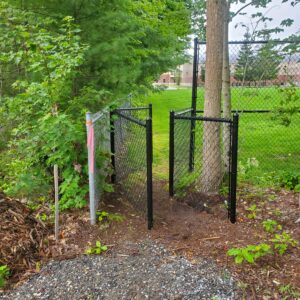
As a vision rehabilitation therapist, my usual goal in writing for LowVisionTech.com is to write about accessibility in the blindness, or low vision space. In this post I want to talk about accessibility in the mobility space.
Five months ago, while walking the dog between a new development in my community, The Cottages at Coastal Pines (Calesa Estates), and the Middle School of the Kennebunks, RSU 21, I discovered a new gate installed across the pathway from the development to the school’s recreational fields. It narrowed to 25 inches. I wondered, at 25 inches, who might be prevented from passing through this gateway? One of the selling points of this new community, according to the Coastal Pines website is, “close proximity to schools.” Indeed, this is a perfect place for anyone with middle school kids, unless of course, the kids use crutches or a wheelchair to walk to school, or the parents use a walker, or have an infant in a stroller.
 A quick check of the nearly 34-year-old Americans with Disabilities Act (ADA) guidelines confirmed that an accessible public pathway needs to be 32 inches, and a call to Disability Rights Maine indicated it needed to be a minimum of 36 inches. In either case, this new gate appeared to be a violation of the ADA.
A quick check of the nearly 34-year-old Americans with Disabilities Act (ADA) guidelines confirmed that an accessible public pathway needs to be 32 inches, and a call to Disability Rights Maine indicated it needed to be a minimum of 36 inches. In either case, this new gate appeared to be a violation of the ADA.
So, clearly, I thought, this was an oversight by the developer, Massachusetts-based Cottage Advisors? An email to the Town of Kennebunk Community Development department will get this resolved quickly. After all, in the Kennebunk Comprehensive Plan finalized in 2022, the phrase “universally accessible,” appears 11 times and one of the town’s aspirations is stated on page 178 as, “The need to preserve and protect open space and have it be universally accessible.”
In the three months it took to receive a response to this email from the town, I contacted Disability Rights Maine, who suggested contacting the school district. An email was sent to the superintendent of school district, RSU 21, who contacted the Director of Operations, who completed the finger-pointing circle by contacting the Kennebunk Community Development office and ultimately passing along a memo from Kennebunk’s Director of Community Development.
In this four-page memo, it in effect stated that the pathway, leading up to the “maze gate” was not specified in the original plans to be an accessible path. As a result, adhering to ADA guidelines, in our community, which aspires to “universally accessible,” is not necessary because it was overlooked in the original plan for the Coastal Pines development. So until the Coastal Pines Home Owners Association (HOA), wants their road to be considered a Town road, to be eligible for trash pickup, plowing, etc., the developer can install a barrier, like the current maze gate, to prohibit certain residents and community members from passing through, based solely on their means of mobility.
The bottom line here is that while the finger-pointing goes on and probably will until the last minute when the residents of Coastal Pines realize that this might stand in the way of having their development’s road approved for Town Services, anyone in the community trying to access the school or the Dorothy Stevens Community Center next door to the school will be denied access through this pathway, unless they meet the criteria of the maze gate and those who installed it. For more information on an HOA’s responsibility, check out HOA Compliance with the American with Disability Act (ADA).
Although “accessibility,” and “inclusion,” are popular buzz words these days, and rightly so, this example of how accessibility is handled at a local level, leaves me with the impression that we have a long way to go before we are actually walking the talk. I don’t think for a moment that the developer, Cottage Advisors, or the Coastal Pines (Calesa Estates) Home Owner’s Association intentionally set out to deny children or athletes who use wheelchairs at the Middle School of the Kennebunks from walking home with their friends through this pathway. I am, however, dumbfounded at the apathy demonstrated by the Town Planner, RSU 21 Superintendent, and School Board. How will “universally accessible” be built into our community if it is not planned for at the outset, when we are designing walkways and gates, and what message does it send to developers like Cottage Advisors that, when a mistake is made, and members of the community are not included, or denied access, it is not quickly rectified? Sure, it’s inconvenient to rebuild the gate with something that is ADA compliant, and it would have been cheaper and far more convenient to plan for an ADA compliant pathway at the outset.
Regardless of the finger-pointing… it’s the law—a 33-year-old law.
Follow-up letter to the editor published 1/16/24 in Portland Press Herald https://www.pressherald.com/2024/01/16/letter-gate-compromises-ada-compliance-in-kennebunk/.